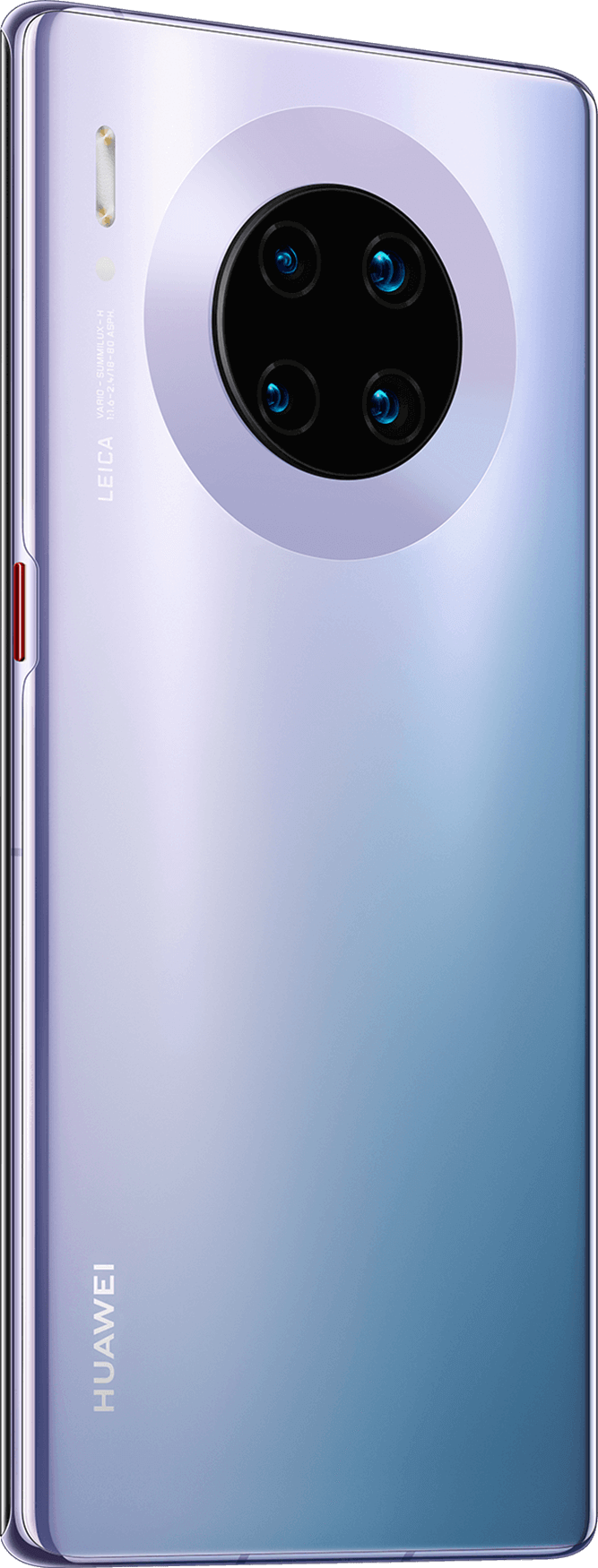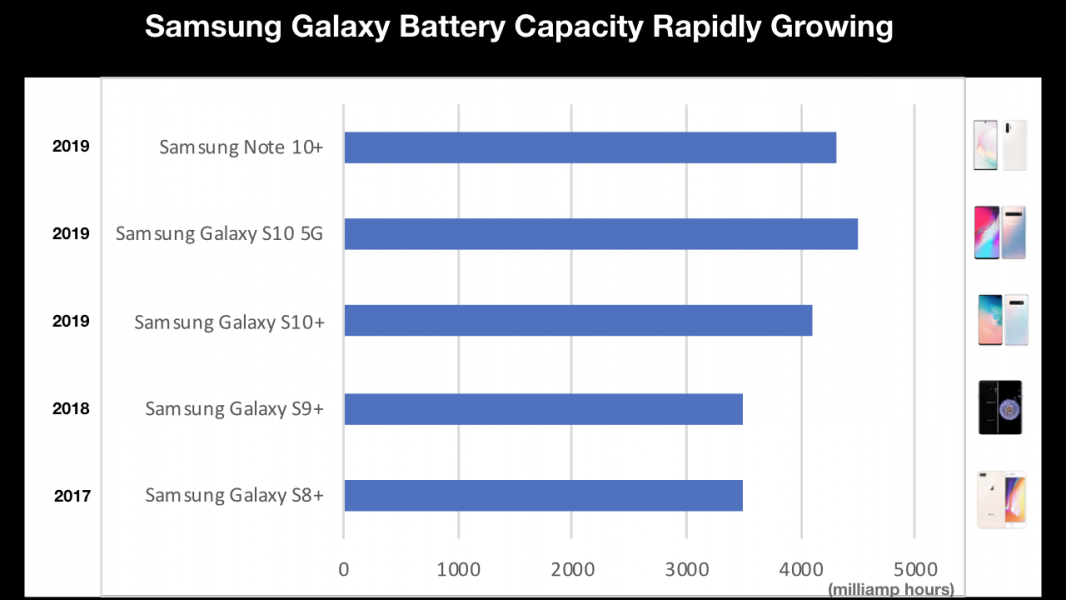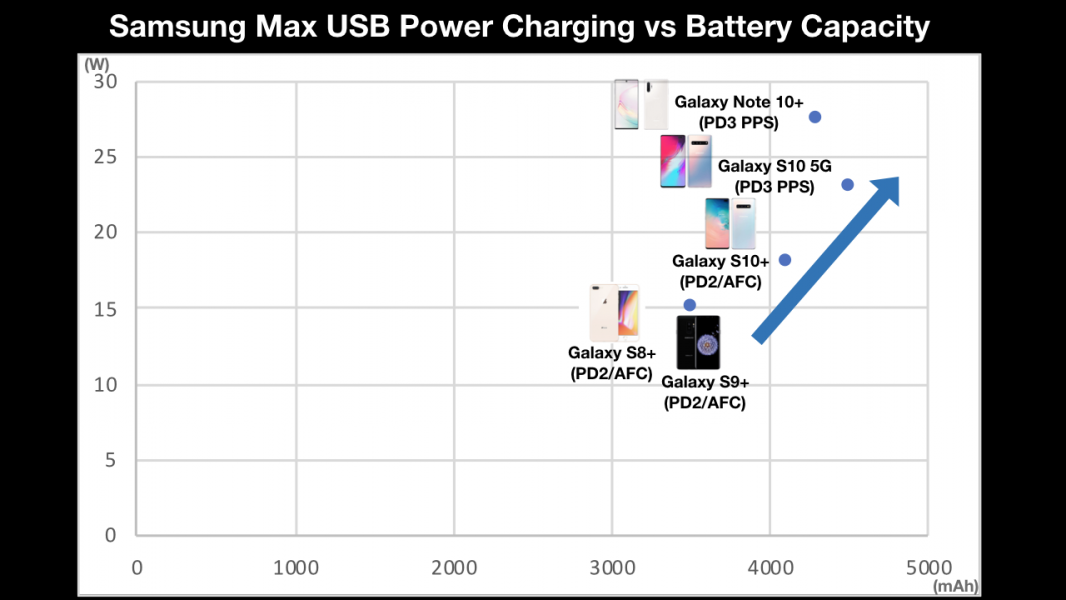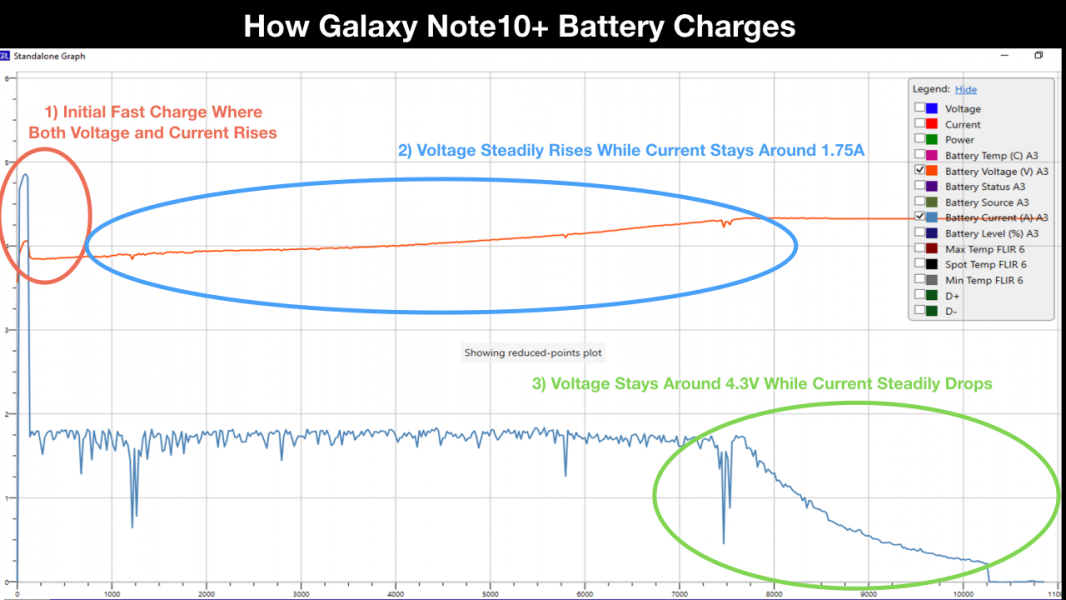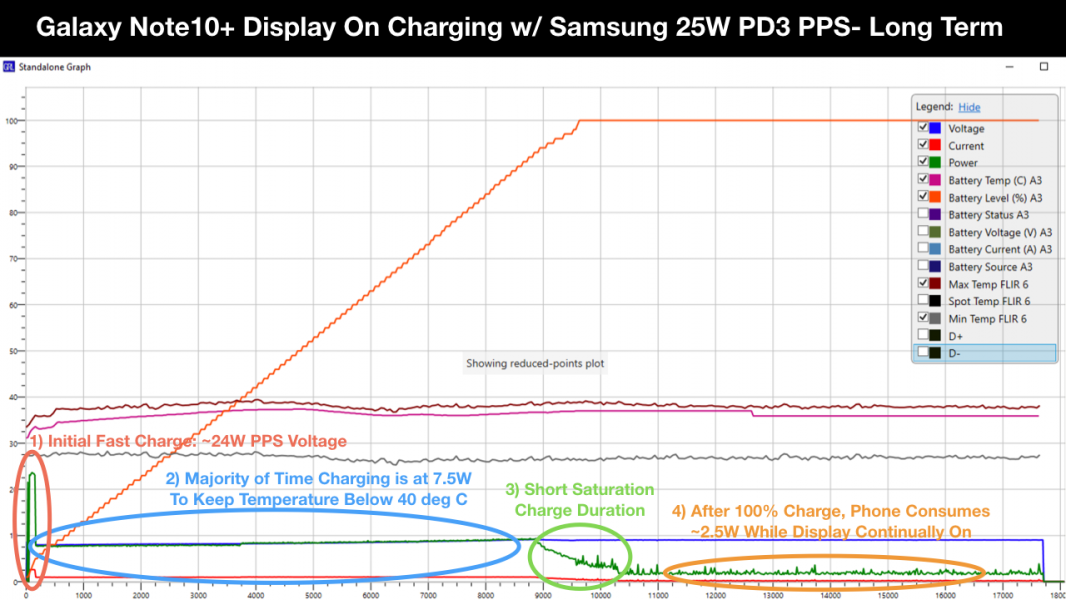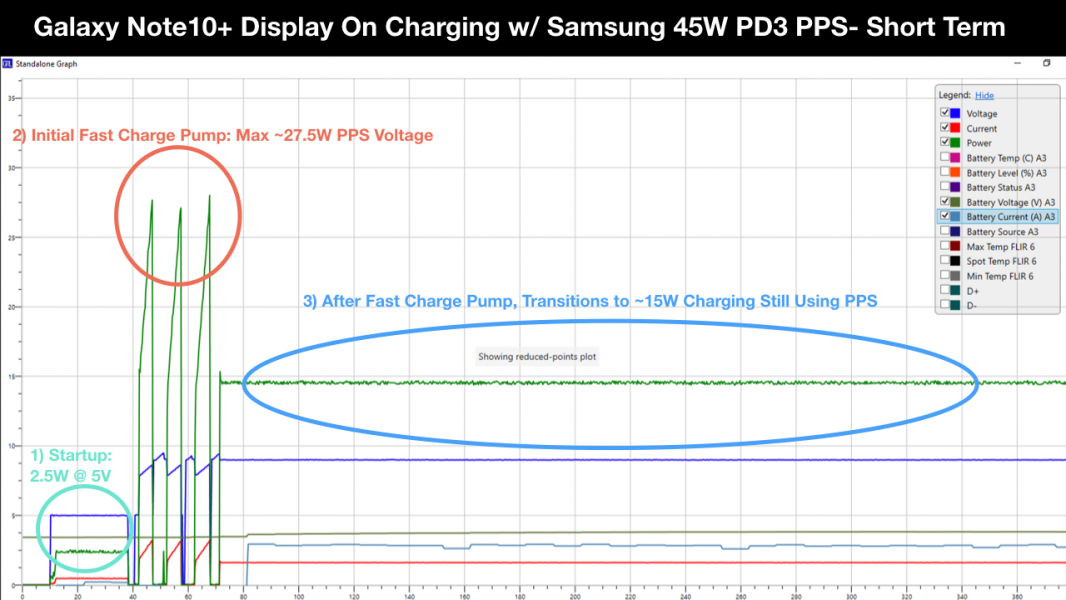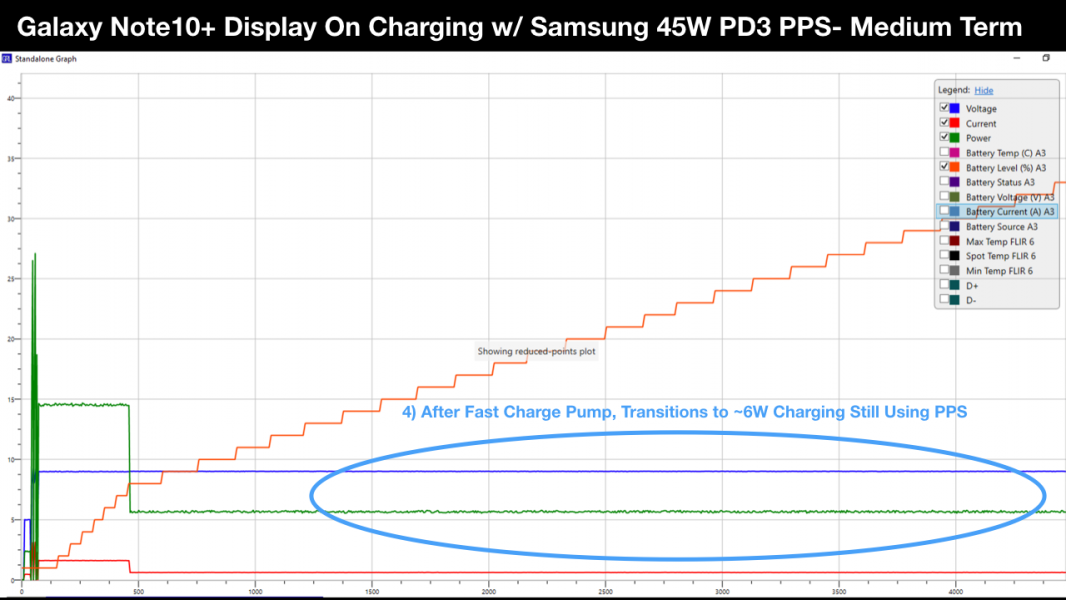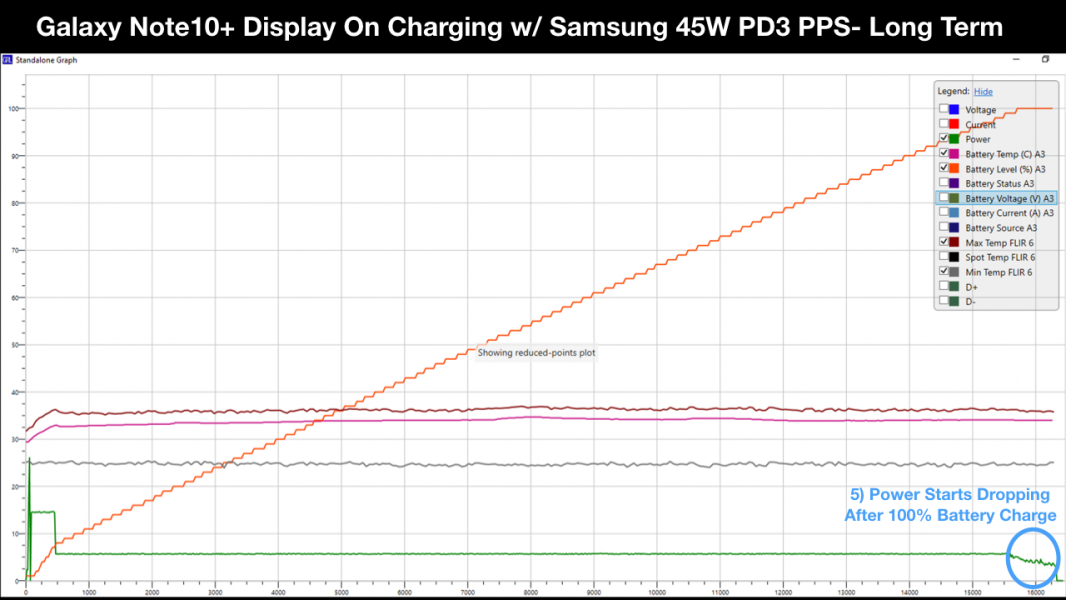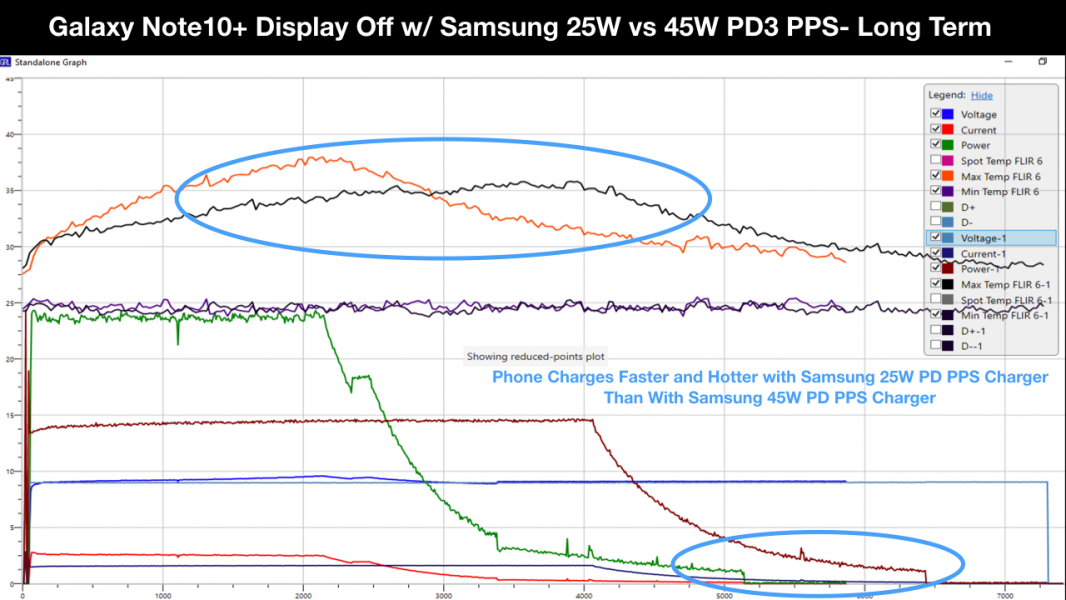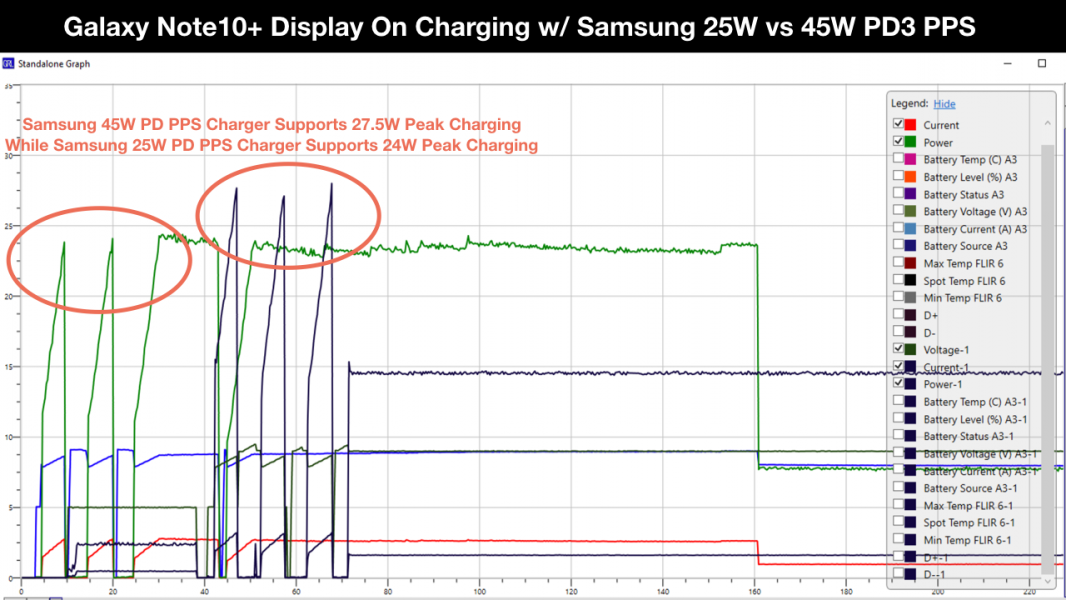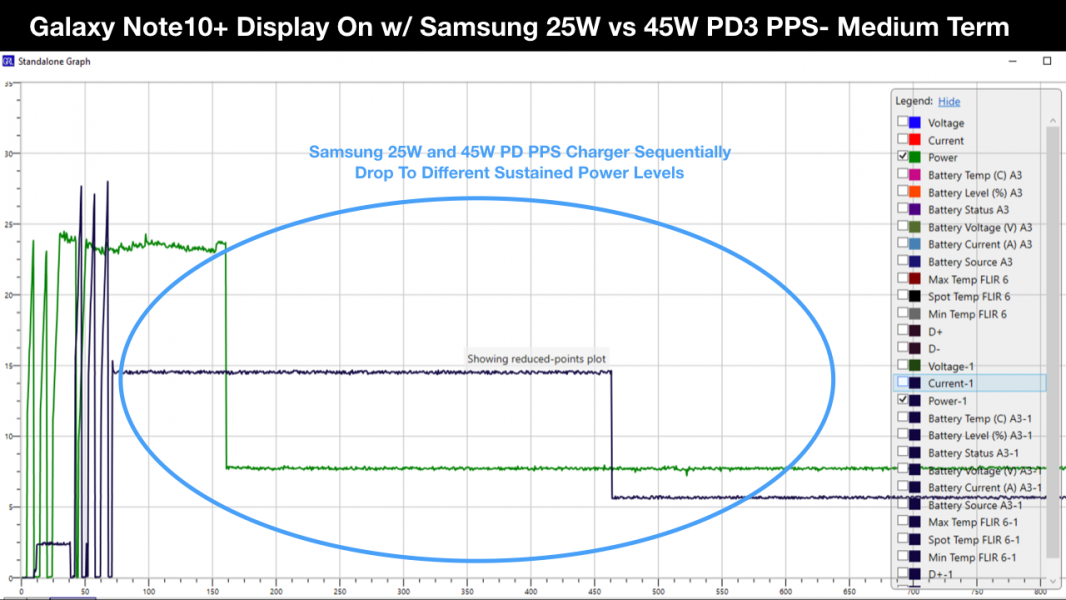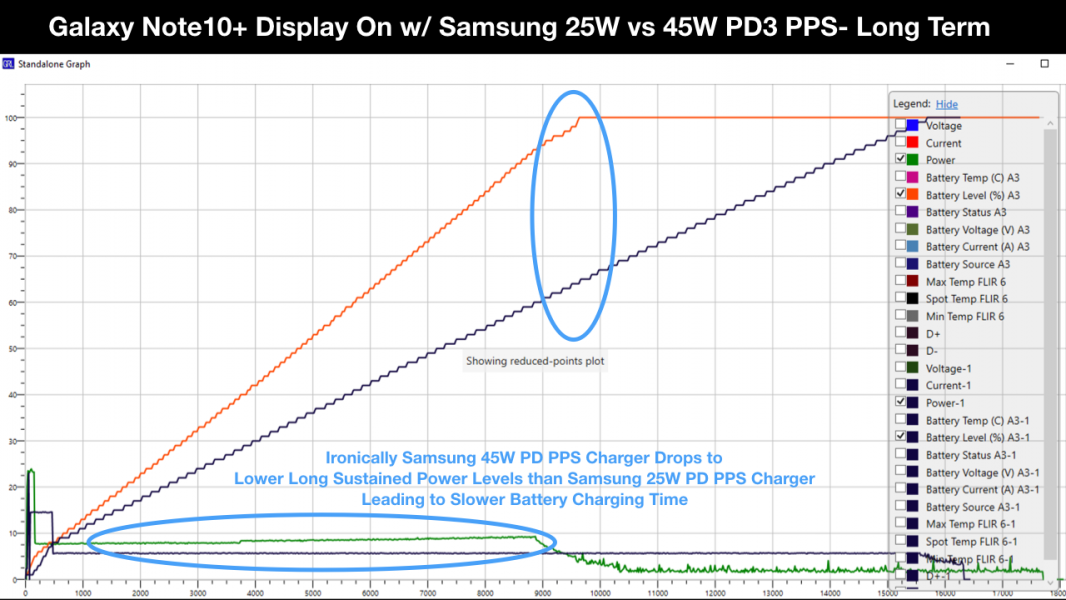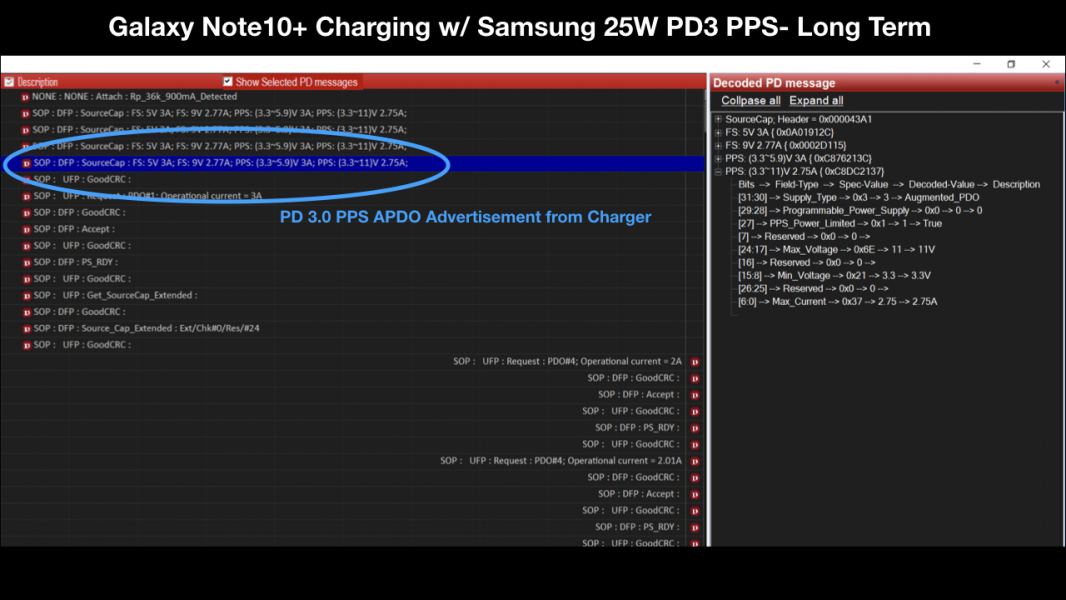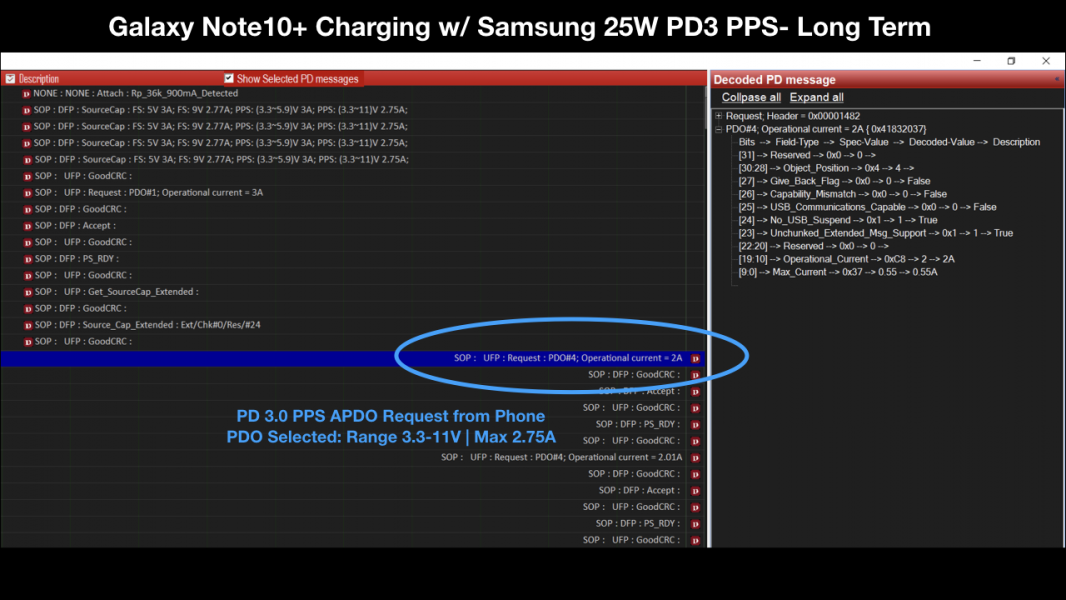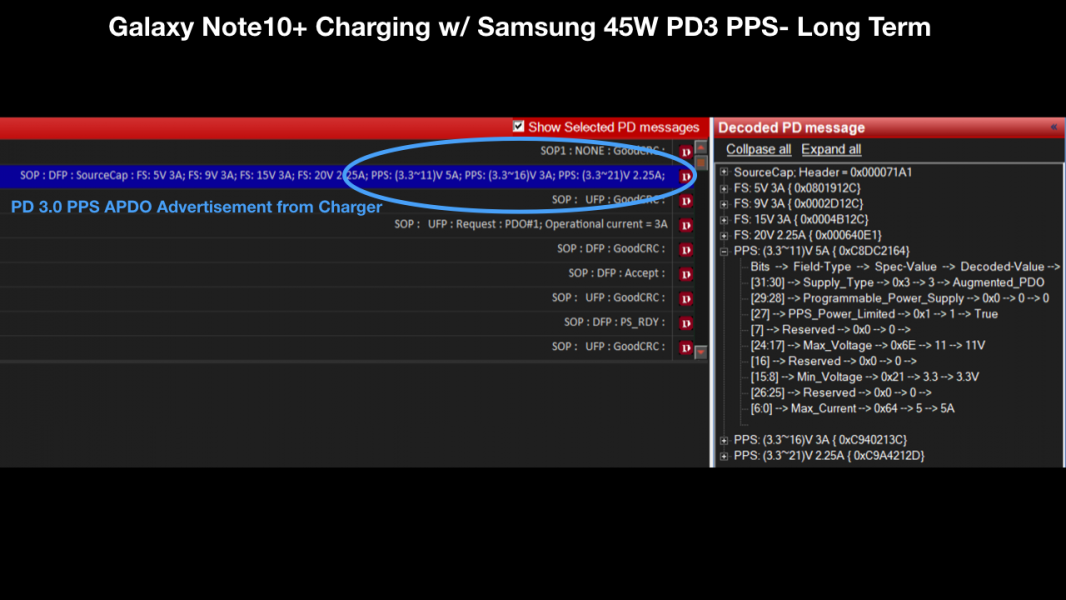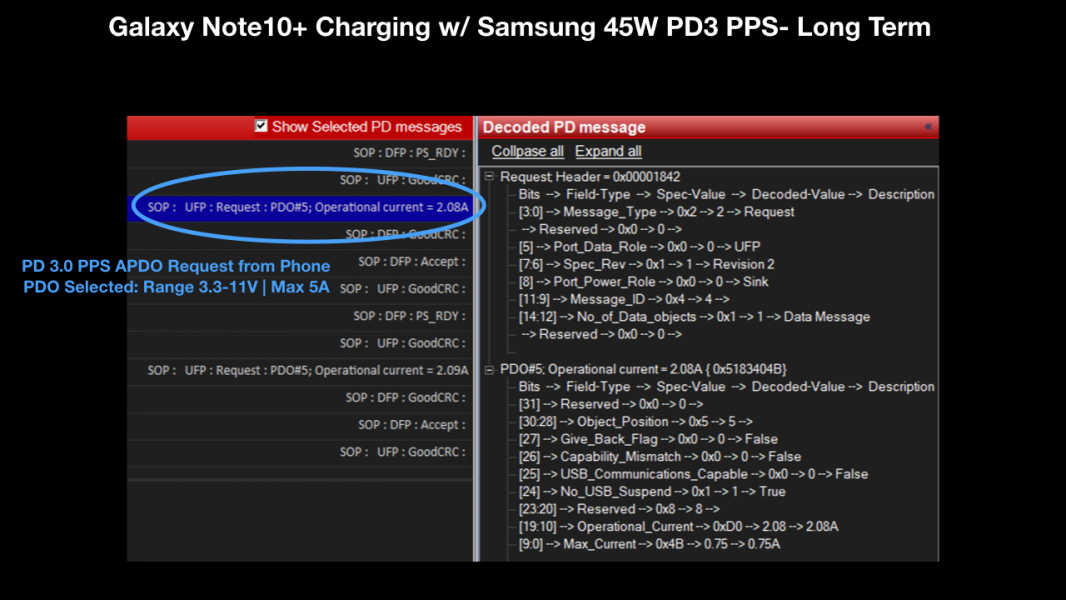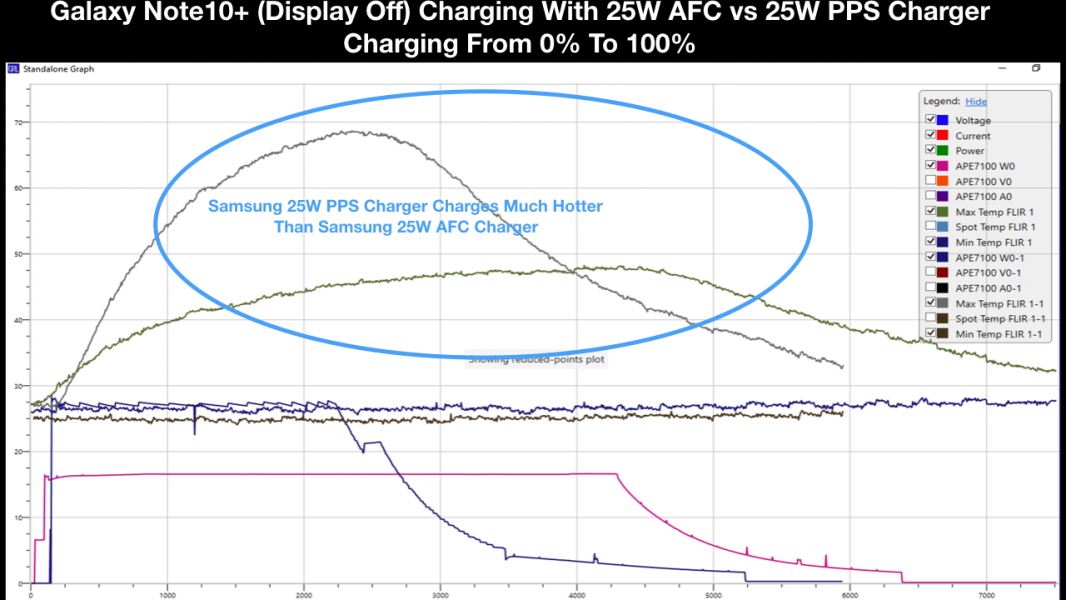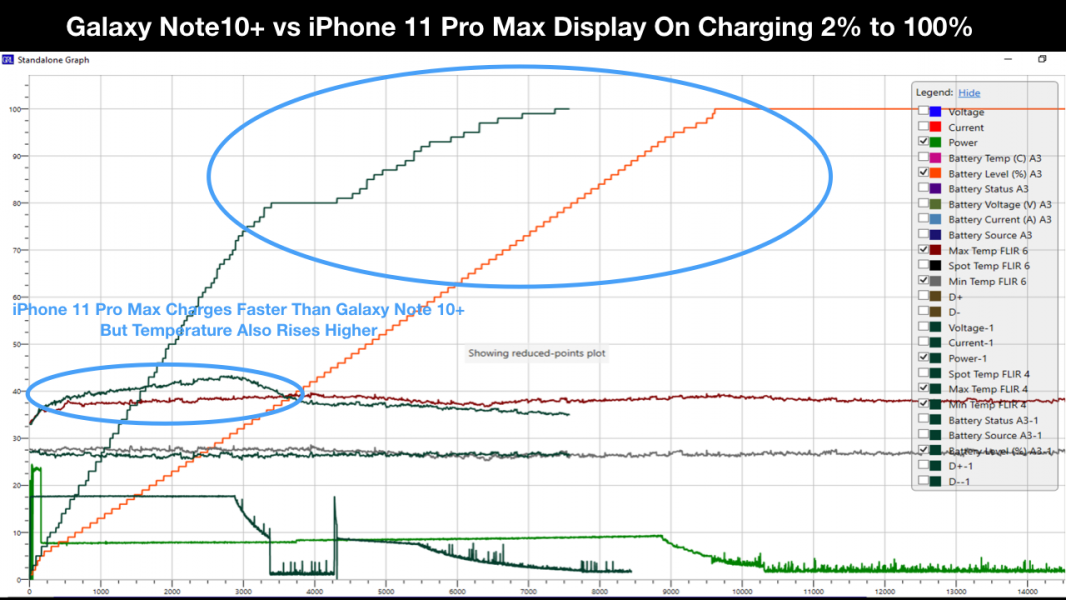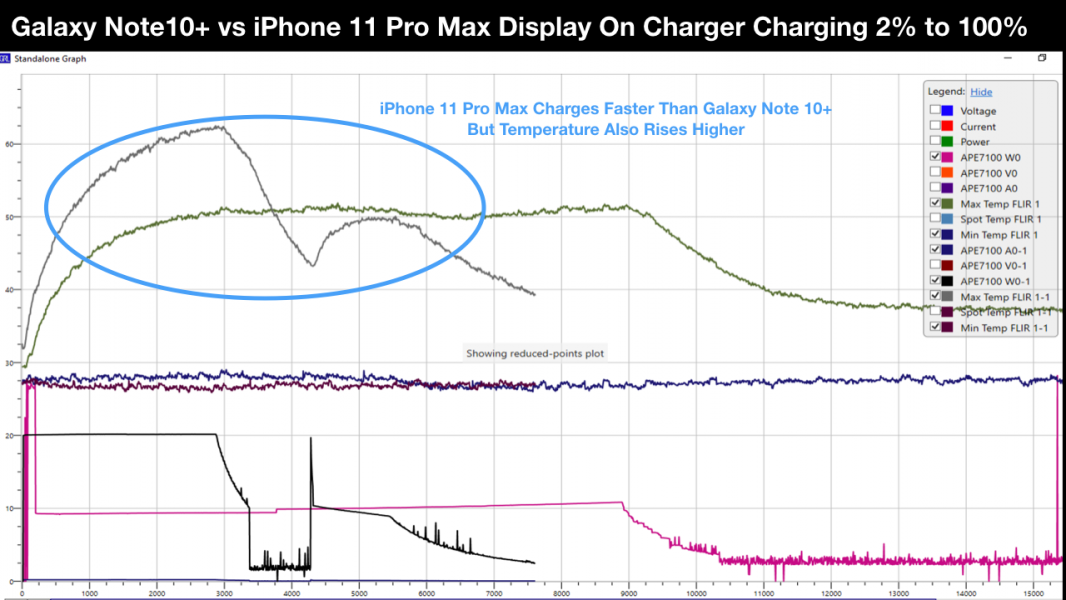Samsung has made big increases to the Galaxy phone battery capacity in 2019 where now the Samsung Galaxy Note10+, Galaxy S10 5G, Samsung Galaxy S10+ have 17-29% larger capacities than the Samsung Galaxy S9+.and Samsung Galaxy S8+ from the previous two years.
Even though the Samsung Galaxy S9+ and Samsung Galaxy S8+ both supported USB Power Delivery, they charged at only a max of 15W. The Samsung Galaxy S10+ increased max charging power by 17% to match the 17% increase in battery capacity over the Samsung Galaxy S9+ and Samsung Galaxy S8+. The Samsung Galaxy Note10+ and Galaxy S10 5G increased max power charging even more dramatically, reaching 27.5W and 25W respectively (although for only brief periods while the display is active). Note the Samsung Galaxy Note10+ and Galaxy S10 5G now also use USB PD 3.0 with PPS (Programmable Power Supply) which allows for charging at variable rather than only fixed voltage levels.
Let's first look at how smartphone Li-ion batteries charge in general, by using the GRL-PSP Power Analyzer software from Granite River Labs and the GRL Battery Monitor App running on the Samsung Galaxy Note10+ while the phone's display is active. The Samsung Galaxy Note10+ first enters a “Fast Charge” mode where both battery voltage and current are rising. The phone proceeds to a “Cool Down” mode where the battery's voltage increases steadily while the current stays within a range. Finally, the phone enters a “Saturation” mode at which point the phone’s battery voltage is already at the highest level and stays there while the current gradually gets lowered to zero until the phone’s battery is 100% full.
Now, let's add the GRL-C2 USB PD Tester and GRL-PSP Power Analyzer software to test and analyze how the Samsung Galaxy Note10+ charges using the Samsung 25W PD 3.0 PPS Type-C Charger that was shipped in-box with the phone.
When the Samsung Galaxy Note10+ is fully drained and kept off, we connect the phone to the Samsung 25W PD 3.0 PPS Type-C Charger. During the “Fast Charge” mode, VBUS power stays around 24W while VBUS voltage varies around 9V, with the phone external temperature (which is recorded using a FLIR camera) increasing by 13° C. During “Cool Down” mode, VBUS voltage drops slightly while current drops steadily which helps to reduce the phone temperature as well. Finally, in “Saturation” mode the VBUS voltage stays constant while current gradually gets lowered to zero until the phone’s battery is 100% full.
We now repeat the same testing and analysis, but this time with the Samsung Galaxy Note10+ drained to 1% and with the display and WI-FI kept active. Here, we see that during the “Fast Charge” mode, VBUS power stays at 24W for a very short period of time before going into a “Cool Down” mode where power is kept mostly at 7.5W. This conservative approach keeps the phone temperature below 40° C at the price of much longer charging time. "Saturation" mode starts when the battery charge hits 93% and is of relatively short duration. We can also see that after the battery has reached 100% charge, with the display and WI-FI kept active, the phone is consuming about 2.5W.
If we zoom in on the “Fast Charge” mode where the phone's display and WI-FI are kept active, we can see that initially USB VBUS voltage and current ramp up at the same time such that power reaches 24W before dropping back down and repeating similar behavior. Samsung may be doing this to condition new batteries since we have seen the Galaxy S10 5G initially have this same behavior but later stops having this repeated voltage/current ramp after some number of battery charge cycles.
If we zoom out to see the entire charging cycle and just focus on the USB VBUS voltage and current, it's clear that the Samsung Galaxy Note10+ is using variable voltage levels which is possible through USB PD 3.0 based PPS technology.
Let's see what happens if we use a higher power USB PD 3.0 PPS charger with the Samsung Galaxy Note10+, this time connecting the Samsung 45W Super Fast Charge Wall Charger.
Overall, we see similar charging patterns as with the Samsung 25W PD 3.0 PPS Type-C Charger but this time max power during the “Fast Charge” mode goes up to 27.5W but surprisingly, the overall charging time is slower when using the higher power Samsung 45W Super Fast Charge Wall Charger. Using the GRL-PSP Power Analyzer software, we can directly compare the Samsung Galaxy Note10+ charging behavior between the Samsung 25W PD 3.0 PPS Type-C Charger and Samsung 45W Super Fast Charge Wall Charger.
When the display is off, the Samsung Galaxy Note10+ full charging is achieved 20% faster with the Samsung 25W PD 3.0 PPS Type-C Charger versus the Samsung 45W Super Fast Charge Wall Charger, and charges at a lower temperature.
When the Samsung Galaxy Note10+'s display and WI-FI are kept on, we can see that now full charging is achieved about 40% faster with the Samsung 25W PD 3.0 PPS Type-C Charger versus the Samsung 45W Super Fast Charge Wall Charger. What's going on here? Shouldn't a 45W charger charge faster than a 25W charger especially when the phone and chargers are all from Samsung?
Most of the difference in charging time is due to the fact that except for the initial “Fast Charge” mode, the Samsung Galaxy Note10+ generally chooses to charge at a lower current with the Samsung 45W Super Fast Charge Wall Charger.
Looking more closely at the USB Power Delivery protocol trace, we can see that the Samsung Galaxy Note10+ chooses the 3.3-11V@Max 2.75A APDO (Augmented Power Delivery Object) advertised by the Samsung 25W PD 3.0 PPS Type-C Charger.
However, with the Samsung 45W Super Fast Charge Wall Charger, the Samsung Galaxy Note10+ sees different APDO's being advertised and chooses the 3.3-11V@Max 5A APDO. With this APDO selection, the Samsung Galaxy Note10+ takes an even more conservative approach focusing more on temperature conservation rather than charging speed.
The Samsung Galaxy Note10+ supports both USB PD 3.0 PPS as well as Samsung's own AFC technology so we can compare which one charges faster. Here we compare between the Samsung 25W PD 3.0 PPS Type-C Charger versus the Samsung 25W USB-C Fast Charging Wall Charger, both of which achieve 25W max charging.
With the Samsung Galaxy Note10+ completely discharged and connecting the charger without turning on the phone, we can see that the phone charges faster and cooler with the USB standards based Samsung 25W PD 3.0 PPS Type-C Charger versus the Samsung proprietary based Samsung 25W USB-C Fast Charging Wall Charger. Most of AFC (Adaptive Fast Charging) based fast charging is done at near 15W while USB Power Delivery (PD) achieves 24W. Because USB PD achieves faster initial charging, the Samsung Galaxy Note10+ can go to cool down mode earlier while continued 15W AFC charging keeps on increasing the phone temperature.
However, we can see that the Samsung 25W PD 3.0 PPS Type-C Charger charges at a higher temperature, reaching 68° C while the Samsung 25W USB-C Fast Charging Wall Charger only reaches about 48° C. Using USB PD 3.0 PPS technology, Samsung has achieved faster charging behavior while shifting the temperature burden to the charger rather than the phone.
To see how Samsung prioritizes lower phone temperature over faster charging, we can compare the different charging behavior between the Samsung Galaxy Note10+ and the Apple iPhone 11 Pro Max.
One of the main differences between these two phones is that the Samsung Galaxy Note10+ supports USB PD 3.0 PPS variable VBUS voltages while the Apple iPhone 11 Pro Max uses USB PD 2.0 fixed VBUS voltages. We can see that the Apple iPhone 11 Pro Max's USB charging uses fixed 9V and 5V charging levels while the Samsung Galaxy Note10+'s USB charging voltage stays in the 8-9V range. We can also see that the Apple iPhone 11 Pro Max uses much more aggressive current management to reduce temperature.
When we look at the overall charging behavior, the Apple iPhone 11 Pro Max charges much faster than the Samsung Galaxy Note10+ but at a higher temperature. The Apple iPhone 11 Pro Max charges at a higher rate of charging initially but after 80% charge, the charging rate flattens out more than the Samsung Galaxy Note10+.
When comparing with the Apple iPhone 11 Pro Max discharging under the same conditions, we can see that the Apple iPhone 11 Pro Max reports staying at 100% battery charge longer while the Samsung Galaxy Note10+ reports linear battery discharging right from the beginning. Both phones discharge to 0% battery at roughly the same time.
The Samsung Galaxy Note10+ is part of a larger trend in 2019 for smartphone displays and batteries to get larger and max charging rates move from a 15-22.5W range to a higher 22.5-27W range seen in competing phones like the Apple iPhone 11 Pro Max, Xiaomi Mi 9 Pro 5G, and Huawei Mate30 Pro. We'll take a close look at these phones in other posts.
Click here to see how the Apple iPhone 11 Pro Max charges using USB Power Delivery.
 GTrusted
GTrusted










